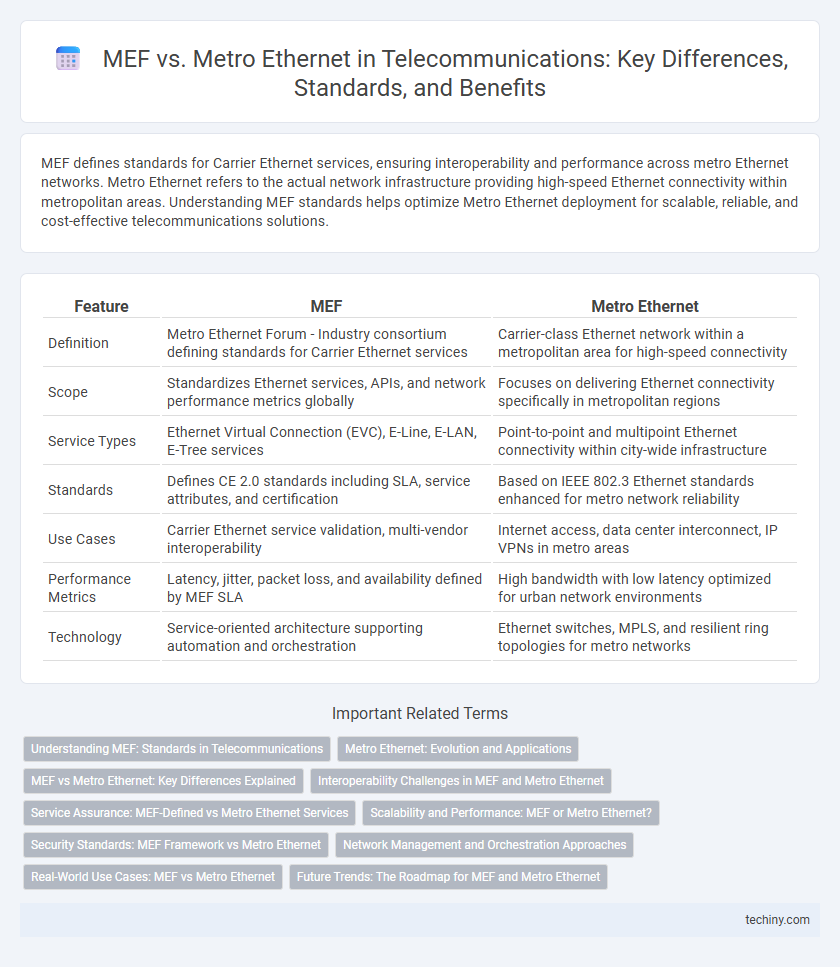MEF defines standards for Carrier Ethernet services, ensuring interoperability and performance across metro Ethernet networks. Metro Ethernet refers to the actual network infrastructure providing high-speed Ethernet connectivity within metropolitan areas. Understanding MEF standards helps optimize Metro Ethernet deployment for scalable, reliable, and cost-effective telecommunications solutions.
Table of Comparison
| Feature | MEF | Metro Ethernet |
|---|---|---|
| Definition | Metro Ethernet Forum - Industry consortium defining standards for Carrier Ethernet services | Carrier-class Ethernet network within a metropolitan area for high-speed connectivity |
| Scope | Standardizes Ethernet services, APIs, and network performance metrics globally | Focuses on delivering Ethernet connectivity specifically in metropolitan regions |
| Service Types | Ethernet Virtual Connection (EVC), E-Line, E-LAN, E-Tree services | Point-to-point and multipoint Ethernet connectivity within city-wide infrastructure |
| Standards | Defines CE 2.0 standards including SLA, service attributes, and certification | Based on IEEE 802.3 Ethernet standards enhanced for metro network reliability |
| Use Cases | Carrier Ethernet service validation, multi-vendor interoperability | Internet access, data center interconnect, IP VPNs in metro areas |
| Performance Metrics | Latency, jitter, packet loss, and availability defined by MEF SLA | High bandwidth with low latency optimized for urban network environments |
| Technology | Service-oriented architecture supporting automation and orchestration | Ethernet switches, MPLS, and resilient ring topologies for metro networks |
Understanding MEF: Standards in Telecommunications
MEF, formerly known as the Metro Ethernet Forum, defines global standards for Carrier Ethernet networks, ensuring interoperability, service quality, and scalability across providers. Metro Ethernet refers to the high-speed Ethernet infrastructure that connects users to metropolitan area networks, commonly used for business access and data center connectivity. Understanding MEF standards is crucial for implementing consistent service level agreements (SLAs) and enabling seamless integration of Ethernet services in telecommunications.
Metro Ethernet: Evolution and Applications
Metro Ethernet has evolved as a high-capacity, scalable networking technology designed to deliver Carrier Ethernet services across metropolitan area networks (MANs). It leverages standardized Ethernet protocols defined by the Metro Ethernet Forum (MEF) to ensure interoperability, quality of service (QoS), and simplified service delivery for enterprise and residential customers. Its widespread adoption supports applications such as cloud connectivity, data center interconnects, and broadband access with enhanced bandwidth efficiency and low-latency performance.
MEF vs Metro Ethernet: Key Differences Explained
MEF (Metro Ethernet Forum) is an industry consortium that defines standards and certifications for Carrier Ethernet services, ensuring interoperability and consistent service quality across networks. Metro Ethernet refers to a high-speed, scalable Ethernet network that connects users within metropolitan areas, typically offering Layer 2 connectivity. The key difference lies in MEF providing standardized frameworks and guidelines for Metro Ethernet deployment, while Metro Ethernet itself represents the actual network infrastructure enabling metropolitan-scale Ethernet services.
Interoperability Challenges in MEF and Metro Ethernet
Interoperability challenges in MEF and Metro Ethernet stem from varying compliance with MEF standards across different vendor equipment, leading to inconsistent service performance and management complexities. Differences in implementation of MEF-defined services such as Carrier Ethernet 2.0 often cause compatibility issues in multi-vendor environments. Network operators must invest in rigorous testing and certification processes to ensure seamless connectivity and standardized service delivery within Metro Ethernet networks.
Service Assurance: MEF-Defined vs Metro Ethernet Services
MEF-defined services provide standardized service assurance frameworks with clearly defined performance metrics such as latency, jitter, and packet loss, ensuring consistent quality across multi-vendor environments. Metro Ethernet services often rely on proprietary mechanisms for service assurance, which can lead to variability in performance monitoring and troubleshooting capabilities. Employing MEF standards enhances interoperability and simplifies service level agreement (SLA) management for reliable and measurable Ethernet service delivery.
Scalability and Performance: MEF or Metro Ethernet?
MEF-certified networks provide standardized scalability and performance guarantees critical for multi-vendor interoperability, enabling seamless service expansion and higher quality of service. Metro Ethernet, while offering high bandwidth and low latency within metro areas, often lacks the rigorous standardization framework found in MEF specifications, which can limit consistent performance and scalability across diverse network environments. Enterprises demanding robust scalability and predictable performance typically benefit more from MEF-compliant Ethernet services due to their adherence to global service definitions and metrics.
Security Standards: MEF Framework vs Metro Ethernet
The MEF framework enforces stringent security standards through its Carrier Ethernet specifications, emphasizing robust authentication, encryption, and traffic isolation to protect data integrity across multi-operator networks. In contrast, Metro Ethernet security typically depends on individual service providers' implementations, leading to varied protection measures that may lack standardized enforcement. MEF's uniform security protocols ensure consistent compliance and interoperability, making it more reliable for safeguarding metropolitan Ethernet infrastructure.
Network Management and Orchestration Approaches
MEF (Metro Ethernet Forum) standards emphasize standardized network management and orchestration using Lifecycle Service Orchestration (LSO) APIs for automated service provisioning and real-time monitoring. Metro Ethernet implementations typically rely on vendor-specific management tools, which can limit interoperability and automation capabilities compared to MEF's unified framework. MEF-driven orchestration enhances scalability and service agility by enabling multi-vendor, multi-domain management aligned with industry-defined policies.
Real-World Use Cases: MEF vs Metro Ethernet
MEF (Metro Ethernet Forum) standards enable service providers to deliver scalable, secure, and flexible Ethernet services across metropolitan and wide-area networks, supporting real-world applications such as cloud connectivity, data center interconnects, and SD-WAN deployments. Metro Ethernet serves as the underlying technology for high-bandwidth, low-latency connections ideal for enterprise LAN extensions, video streaming, and VoIP services within metropolitan areas. Enterprises leverage MEF-compliant Metro Ethernet solutions to ensure interoperability, service orchestration, and SLA-driven performance in dynamic multi-vendor environments.
Future Trends: The Roadmap for MEF and Metro Ethernet
MEF standards are key drivers in advancing Metro Ethernet by enabling automation, service orchestration, and agile connectivity across global networks. Future trends indicate MEF's integration with SDN and NFV will enhance scalability, performance, and dynamic service provisioning, essential for 5G and IoT applications. Metro Ethernet's evolution under MEF's framework supports programmable networks and AI-driven analytics, positioning it as a cornerstone for next-generation carrier-grade services.
MEF vs Metro Ethernet Infographic

 techiny.com
techiny.com